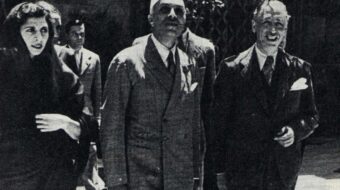Translated by Karen Grimwade
(‘Humanite) Mexican literature, guest of honour at the 2009 Paris Book Fair, feeds on indigenous, Latin American, and international influences, presenting a literary production that could make one appreciate globalisation.
As far as French readers have been concerned, Mexican literature has long been summed up by reference to two authors : Octavio Paz and Carlos Fuentes. One could, and still can, qualify them as literary giants. And giants have always overshadowed those who preceded and followed them, as well as their contemporaries.
Naturally this was very unfair to the great modern writers from the thirties to the fifties, Revueltas, Reyes and of course Juan Rulfo, who are being enthusiastically rediscovered today. It also meant ignoring the way post-1968 generations, from Sergio Pitol to Jorge Volpi and Paco Ignacio Taibo II, broke with convention. It meant ignoring all whom the Book Fair will showcase : the 37 attending authors and the equally interesting absentees.
Cortès and his successors
Above all, it meant forgetting that the conquistadors did not arrive in a land devoid of its own literature. Their efforts to wipe out all written expressions of the Nahuatl or Mayan languages are sufficient proof of that. The “codices” that survive today include religious works, calendars, annals, or prophecies such as the famous Books of Chilam Balam, which have been revealed to French readers through the translations of Benjamin Péret and later by JMG Le Clézio. Yet alongside these texts, a diverse and vibrant poetry developed over hundreds of years.
Thus Cortès and his successors exploited the intellectuals within their colony whilst simultaneously imposing Castilian Spanish on them. At the same time, the Spaniards put an end to any cultural exchange between their possessions and the outside world. The novel was even prohibited at the exact same moment that Cervantès reinvented it back in mainland Spain.
But the colonial period cannot be reduced to “dark centuries”. Juana Inés de Asbaje, better known by her religious name of Sor Juana Inés de la Cruz (1651-1695), is a figure that dominates the “Golden Age” with her poems, essays and plays. A companion to the vicereine, her writing bears witness to a learned court and despite her run-ins with religious authorities, she remained famous and admired. Her biography, written by Octavio Paz in 1982, popularised Mexico’s “tenth muse”. As for the playwright Alarcon, who was the inspiration for Corneille’s “Le Menteur” (The Liar), he is such an integral part of Spain’s classical corpus that people often forget that, despite his frequent transatlantic crossings, he was Mexican.
Pancho Villa and Emiliano Zapata
However, the true awakening of Mexican literature didn’t come about until the end of the 19th century : a century marked by the fight for independence beginning in 1810, the loss of 40% of the land – from Texas to California – which was annexed by the United States, and the attempt to become Mexican Emperor by Maximilian of Habsburg, with the support French troops.
The thirty-five-year long “porfiriato” during which Porfirio Diaz was continuously, and more or less fraudulently, re-elected President, was a tranquil period of time during which Mexico steeped itself in a romantic, then realist, literature under the influence of Spain and France. The poet Lopez Velarde and the novelist Federico Gamboa used these bases to build the foundations for a native Mexican literature.
In 1910, Mexico experienced a kind of reformation with the revolution which put an end to Porfirio’s “electoral dictatorship” and saw the emergence of figures such as Pancho Villa and Emiliano Zapata. Despite an ambiguous end to the conflict in 1916-17 and the assassination of their leaders, the cavalrymen of the north and peasants of the south profoundly changed their country. A social and cultural reformation took place, with radical social reforms being carried out.
It was at this time that the revolutionary novel came to be, with Martin Guzman, an opponent of Diaz and then fighter under Pancho Villa. He was the author of “La sombra del caudillo” (The Leader’s Shadow) and “El águila y la serpiente” (The Eagle and the Serpent), written in 1920, titles which refer to the two emblems at the centre of the Mexican flag. Despite presenting typical aspects of the “epic fresco”, these novels nonetheless employ narrative practices that were daring for their time.
The other literary great of this period, Mariano Azuela, published “Los de abajo” (The Underdogs” in 1916, a novel full of committed social realism. A tradition was born, along with the risk of becoming fossilised that success brings. However, the vitality of Mexican culture during the twenties and thirties, the opening up to European arts and literature, and the setting up of trade guilds with other Latin American writers from Argentina, of course, as well as Nicaragua, Cuba and Guatemala, were to hasten the revival process.
Juan Rulfo, born in 1917, has long been overshadowed by his contemporary Octavio Paz (1914) and the younger Carlos Fuentes (1928). His importance has today been re-evaluated. It is true that his oeuvre contains only two titles, a collection of short stories “Contes du llano en flammes” (The Burning Plain) and his one novel Pedro Paramo (1955), which is said to have been influenced by Faulkner, but in which certain patterns, such as the reappearance of deceased characters, bring to mind “magical realism” at its peak. Arreola, with La feria (The Fair), Agustin Yanez, with Al filo del agua (The Edge of the Storm), and Jose Revueltas, with Los días terrenales (The Mundane Days) and Dormir en tierra (To Sleep on the Ground), were also part of this movement.
The group from the Casa del Lago
Octavio Paz, without a doubt Mexico’s best known writer (see the article by Virginie Gatti), should also be cited in order to remind people of the importance of poetry in a literature which is not uniquely composed of novels. Along with Carlos Fuentes, who is considered to be the father of the Mexican novel, one might say they shared the work load. They were close friends for a long time, were both politically committed, and defended each other against the Far Right until a huge disagreement towards the end of the eighties saw them fall out. The two diplomats both resigned for political reasons but remained the ambassadors of Mexican literature, particularly in France.
The student massacre of October 1968 at the Plaza de las Tres Culturas in Tlatelolco heralded the turning of a page. Literature opened up progressively to the outside world, began playing with codes and genre, exploring popular languages and figures of speech. Sergio Pitol – yet another ambassador – leader of the group from the Casa del Lago, skilfully plays with literature within literature and will surely exert an influence over many Hispanic writers outside Mexico. The new generation, born after 1968, shows a freedom which goes hand in hand with a lack of reference points and which renders a speech that is close to our present concerns. It is this literature which dominates at the Book Fair. Disturbing or stimulating, it is diverse enough for everyone to find something with which to while away a few pleasurable hours












Comments